|
|

America – The Covenant Nation © 2021, Volume One, pages 377-386. |

|
|
From asthmatic to sportsman
From his birth in 1858, he grew up in an environment of social privilege, a New York City Roosevelt of a long line of successful Roosevelt businessmen. But young Teddy suffered badly from asthma, which, though nearly killing him, did not keep him from being a most energetic and inquisitive youth. He had a keen interest in biology, plus history, French, German and geography (he was home-schooled but also highly self-taught), resulting greatly from the trips he took abroad with his family to Europe and the Middle East. Also, climbing the Alps with his father, he learned the importance of exercise in fighting the asthma and in rebuilding his body. He eventually even took up boxing. Studies, and his first steps into politics
He went on to study the standard curricula at Harvard, excelling in science and philosophy with his nearly photographic memory. The study of military history also focused much of his attention, as did also boxing and rowing. He was inducted into the prestigious Porcellian Club, was editor of the Harvard Advocate, and graduated Phi Beta Kappa and magna cum laude in 1880. He then went off to Columbia Law school, but found his heart to lie not in law books but in the practical field of politics, becoming active in the local Republican organization. At about the same time (1882) he published research he had undertaken at Harvard on the War of 1812, still even today one of the best studies of that war in print. In the same year he became a member of the New York State Assembly. Tragedy
But tragedy as well as stunning accomplishments followed his life. His father had died in 1878 during his second year at Harvard, leaving him deeply stunned. He married four years later in 1882 at age twenty-two, but his wife died two years later in delivering their first child, Alice. Furthermore, his mother had just died in the same house … only eleven hours earlier. Anti-corruption Progressivist
In deep shock, Roosevelt buried himself in his work, investigating governmental corruption in New York City and taking aim at individuals such as the scheming financier Jay Gould and at corruption both in the Albany capital itself and on the judicial bench. And as chairman of the Committee on Affairs of Cities he was a prolific drafter of reformist legislation. He also in 1882 joined the New York National Guard as a second lieutenant, moving up the ranks to captain, gaining military experience that he would put to use later when the Spanish-American War broke out in 1898. In 1884 he reached higher in Republican politics, gaining chairmanship of the New York Republican Party delegates sent to the national convention that year, over the opposition of Blaine and Arthur. But in the end, he reluctantly agreed to support the Party's ultimate nominee, Blaine. And in the process, he was called upon to deliver a speech before ten thousand delegates, bringing him into the national political spotlight. Blaine went on to lose the election to Cleveland, and Roosevelt retired to his ranch out West in the Dakotas along the Little Missouri River. Shortly after that (1886), as the "Dakota Cowboy," he ran an unsuccessful race for New York City mayor. But that December he finally found success in marrying in London his second wife, Edith, who would deliver five strong children! In 1888 he returned to public life campaigning for Benjamin Harrison, who in becoming president appointed him to the Civil Service Commission, on which Roosevelt served for the next seven years in Washington, D.C. The purpose of the Commission was to counter the spoils system, and Roosevelt proved himself to be a strong enforcer of that policy. This again brought him much favorable public attention. New York City police commissioner
In 1894 he declined the offer of New York
Republicans to run again for the office of mayor, and then soon
regretted the decision. He retreated to the Dakotas again to think
things through, and then quickly accepted the offer to become a member
of New York City's Board of Police Commissioners. Here his strong will
to clean up urban political corruption virtually remade the New York
City police, Roosevelt even going out on his own to inspect officers on
the beat, but also noting along the way the deplorable state of the
city's poor. Eventually his rigor drew the wrath of New York's Tammany
Hall and its Boss Platt, Platt finally taking action to have the Board
of Police Commissioners eliminated. Assistant secretary of the navy
Then in 1897, Roosevelt’s friend Henry Cabot Lodge promoted the appointment of Roosevelt to McKinley’s cabinet as assistant secretary of the navy. It was a very logical appointment, given Roosevelt’s proven knowledge and interest in all matters concerning the Navy.1 With a sickly secretary of the navy as his boss, Roosevelt soon found himself conducting most of the affairs of the navy secretary, including advising McKinley on naval matters, particularly as war with Spain loomed into view. He even took over the preparations for naval war after the blowing up of the battleship Maine in the harbor of Havana, Cuba. The Spanish-American War and Roosevelt's "Rough Riders"
War against Spain was declared on April 25th (1898) and Roosevelt then resigned his cabinet position soon thereafter to take himself to Texas to form, finance, and train his own cavalry regiment, popularly known as the "Rough Riders." A month later this strange array of adventure-seeking young men (ranging from Ivy Leaguers and Eastern gentlemen, to miners, hunters, cowboys and even Indians) shipped off to Cuba. After some minor experience in battle, in June they were directed to act in support of a massive but dangerous charge of American troops uphill across open ground defended by Spanish regulars armed with the latest weaponry, including machine guns and repeating rifles. However, the American machine guns (Gatling guns) poured such fire onto the Spanish during the charge that the Spanish failed to offer effective resistance. Of course the attack involved thousands of other American troops besides the Rough Riders (the Rough Riders actually charged nearby Kettle Hill while the rest of the Americans charged San Juan Hill). This attacking party included numerous Buffalo Soldiers (American Blacks). The latter did much of the heavy fighting, but (of course) received little if any recognition for their effort.2 Actually, the action had cost the Americans dearly: 200 killed and 1,000 wounded, about five Americans for every Spanish soldier suffering the same fate. But the Spanish were put on the run and Santiago was captured two weeks later, virtually ending the war. Colonel Roosevelt was careful to narrate to an adoring press the adventures of his Rough Riders in a way that complemented the other troops, but clearly left the focus on his own troops. As a result, he came out of the action a national hero. He would also remember this event as the very best moment in his life. New York Governor
So well-known was his name at this point that he was asked to run for the position of New York Governor in 1898, which he won in a very tight race. As New York Governor he was immersed in the kinds of larger political issues tha t would prepare him well for higher office (such as U.S. president). He had corruption to clean out, monopolies and trusts to hem in, labor problems to resolve, and, close to his heart, the conservation of New York’s extensive woodlands and rivers to embrace. And he leaned on wealthy businesses to give financial support (taxes) to the New York community that so prospered these businesses. His program he summed up as the "Square Deal" (sounding a lot like his nephew Franklin Roosevelt’s term "New Deal" of some 30 years later). In all this he skillfully led Boss Platt to become an actual supporter of his policies, thus helping Roosevelt get his ideas actually put into play. That was political diplomacy at its finest. The 1900 election
It was this political skill (plus again some intervention by his friend Henry Cabot Lodge) that brought him to the attention of many political figures, both positively and negatively. Both his friends and his enemies saw his selection as vice president as an opportunity ... to march him toward the White House (his friends) and get him out of New York (his enemies). With no one else being put forward for the thankless job of vice president, Roosevelt was nominated as McKinley's new running mate in the 1900 election. It would be a fateful choice. Vice president
Roosevelt campaigned hard for the Republican Party (he loved the challenge dearly), the Party once again running against the equally tireless Democratic Party candidate, Bryan. That November the Republicans delivered an even bigger blow to the Democrat Bryan than before. And Roosevelt stepped into the quite powerless job of vice president. Roosevelt would discover during this time how much he disliked being out of the real action. President
With McKinley's assassination six months into his second term in office (September), Roosevelt stepped up to the office of U.S. president. In some ways he continued McKinley's political program (pro-gold, high tariffs and imperialism) and in other ways he went well beyond McKinley in the way he went after the big trusts that dominated American business, and the way he supported American labor. He faced a huge strike of American coal miners, threatening to send federal troops to break the strike, yet being willing to set up a commission to arbitrate the dispute – which ended in a compromise acceptable to both sides. A Square Deal had been struck. He also backed federal regulation of railroad rates (the 1906 Hepburn Act) to neutralize the monopolistic effect of the industry (only one railroad running through town charging whatever prices it wanted, there being no alternative). The Pure Food and Drug Act was passed also in 1906 (along with other legislation supervising the health of the food and pharmaceutical industries). And being the lover of the woods, fields, streams and mountains of America – and the animals living there – he was particularly active in using federal power to protect undeveloped lands, transforming them into national parks, national forests and game preserves. The Election of 1904
Roosevelt easily won reelection to a second term in 1904, but made the fateful declaration at that time that this would be his last term in office (but serving only two terms was something of a long-standing presidential tradition anyway). It would be a declaration that later he would regret, which he would go back on, producing disastrous unintended consequences, at least for his Republican Party (and, depending on how a person feels about Woodrow Wilson as president, perhaps for the nation). Roosevelt's second term in office
Roosevelt pushed his assault on the wealthy, calling for a national income tax, although the Supreme Court had already ruled that the Constitution allowed for no such tax, which would be permissible only through the passing of a constitutional amendment (which eventually occurred, but not until 1913). He also attempted to reach federal authority into other walks of American life, finding the way blocked again by the fact that there was little or no constitutional warrant for doing so, no matter how noble the cause. He did, however, see through to success the 1907 Tillman Act outlawing corporate contributions to federal political campaigns, a significant step forward (not always respected however) restricting big money manipulation of national elections.3 The Panic of 1907
Once again panic hit Wall Street when a greedy scheme to buy out the stock of huge United Copper Company instead collapsed the value of the company's stock, causing people to withdraw deposits with banks invested in the company. This in turn spread quickly into a general banking and Wall Street scare, forcing bankruptcy on numerous state and local banks, including New York banks holding the reserves of these regional banks. It also dropped overall stock values on Wall Street to half of what they were the previous year. Finally, when the huge Knickerbocker Trust Company collapsed, J.P. Morgan – under an agreement with Roosevelt – stepped in to help buy out failing companies and restore investor confidence in Wall Street. Morgan's U.S. Steel Company also bought out the Tennessee Coal, Iron and Railroad Company (TCIR) just as it too was about to collapse (also under agreement with Roosevelt). Thus it was that during his last years in office the strongly anti-monopolist Roosevelt had to turn to one of his targeted monopolies for help! 1Roosevelt, along with many others, including European heads of state, had been strongly influenced by the 1890 publication by Alfred Thayer Mahan, The Influence of Sea Power upon History, 1660-1783. 2Lieutenant Ord, who lost his life in the attack, and his Buffalo Soldiers, who actually reached the heights of San Juan Hill first, were largely overlooked when honors were being passed around. 3Those
restrictions would even be strengthened by follow-up legislation, until
2010 and then also in 2014, when in two separate decisions, the Supreme
Court ruled that any restriction in the right to contribute to
political campaigns is unconstitutional.
|
Theodore "Teddy" Roosevelt
(U.S. President 1901-1909)
Library of
Congress
Teddy Roosevelt as New York City Police Commissioner
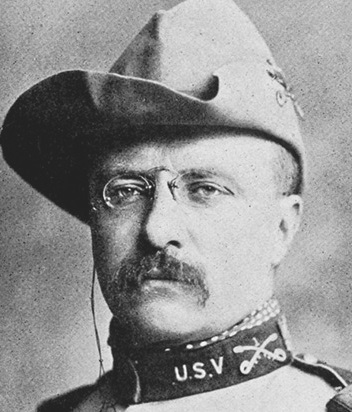
Teddy Roosevelt as commanding officer of the "Rough Riders"
Roosevelt (center) with his Rough Riders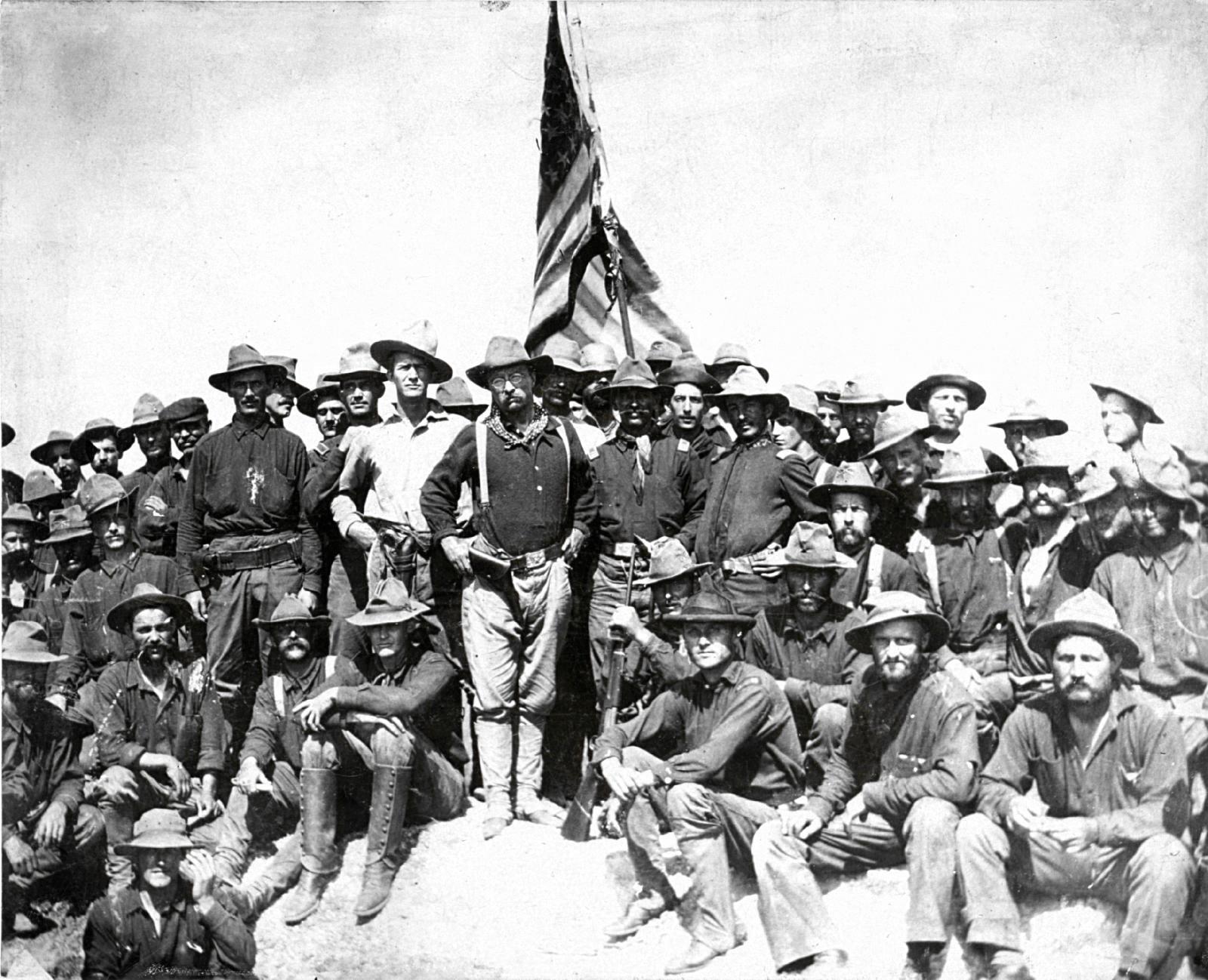
Territorial growth -
1900
Department of the
Interior
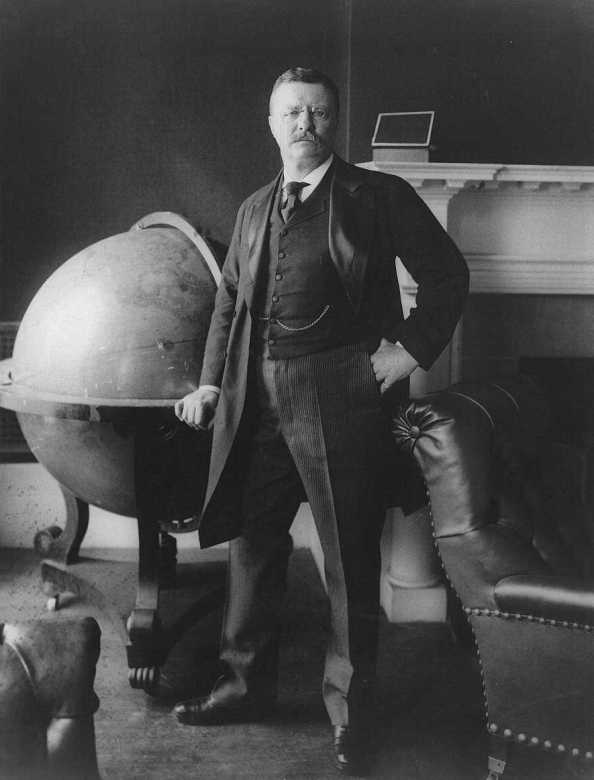
President Theodore Roosevelt - 1903
The Presidential Election of 1904
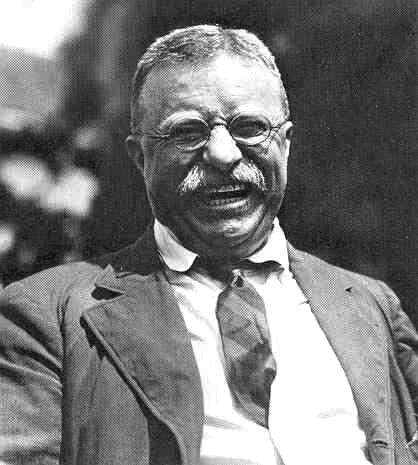
Teddy Roosevelt
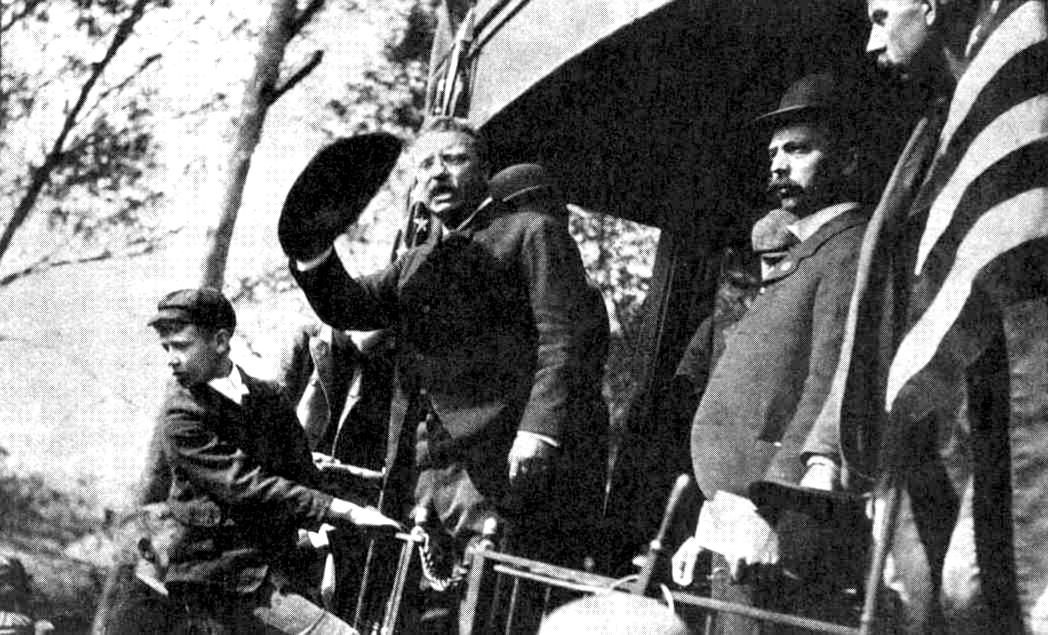
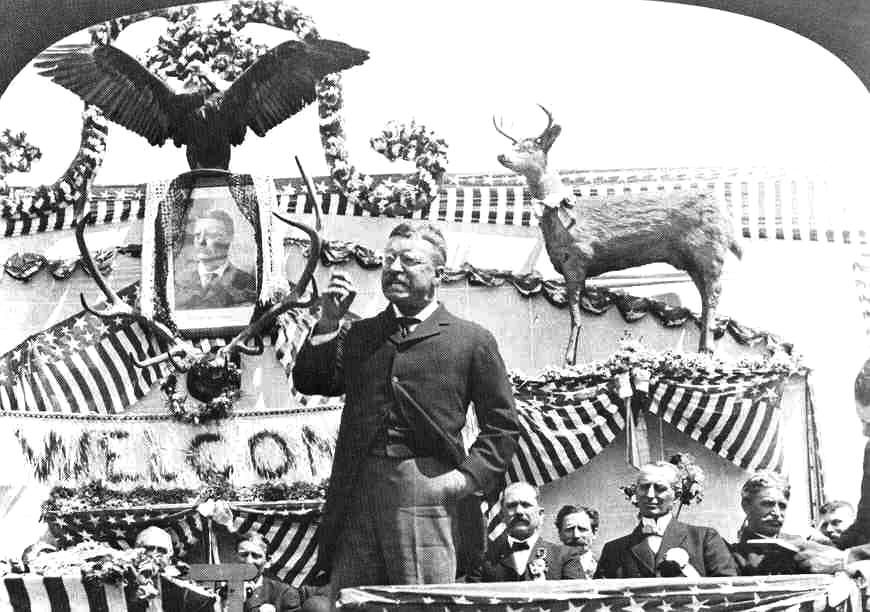
Teddy Roosevelt in the "Bully
Pulpit"
"I have no idea what the
American people think. I only know what they should think."
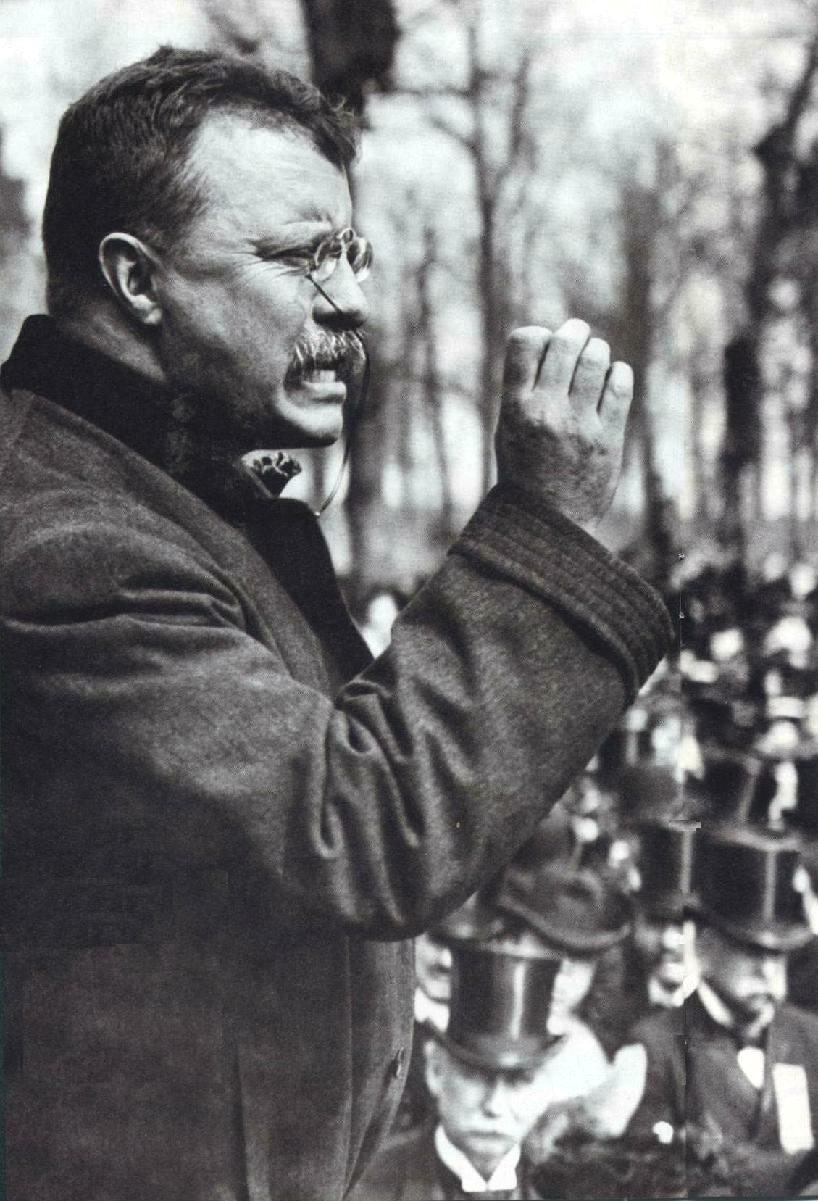
Taking on the "Robber
Barons"
Even out of office, Roosevelt
stayed deeply involved in the nation's politics.
Former President Roosevelt
at the dedication of Grant's tomb – 1910.
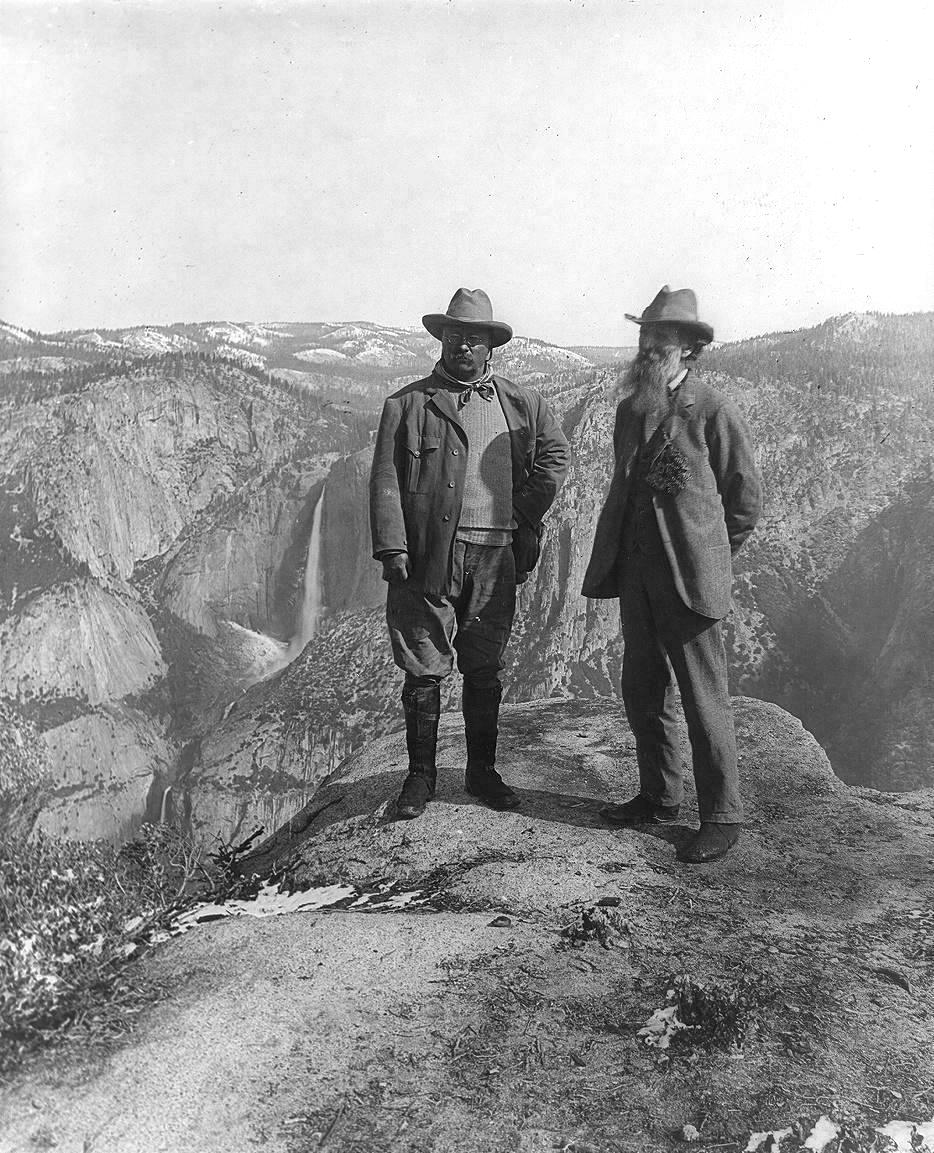
Theodore Roosevelt and John
Muir on Glacier Point, Yosemite Valley, California – ca.1906

|
|
Taft was born into an Ohio political family, his father having been both U.S. attorney general and secretary of war under President Grant. Young Taft grew up under strong parental discipline which made him a hard worker, and eventually a successful student at Yale (graduating 2nd out of 121 students and a member of the prestigious Skull and Bones society). He took up study of the law and was in 1887 appointed a judge by the Ohio governor, while only twenty-nine! In 1886 he married Helen Herron – who continued the push he had received from his parents growing up, helping him reach ever higher in the world of law and politics. Although he hungered for an appointment to the U.S. Supreme Court, President Harrison in 1890 appointed him as U.S. solicitor general (at age thirty-two), where he at least was allowed to argue cases (winning 15 of his 18 cases) before the Supreme Court. Then in 1892 Harrison appointed him to the Sixth Circuit, a natural stepping stone to a Supreme Court appointment. He held this position for the next eight years, becoming a law professor in Cincinnati at the same time. Philippine governor.
In 1900 he was appointed by President McKinley to head up a commission charged with organizing a new government in the recently acquired Philippines (a trophy from the Spanish-American War), under the agreement with McKinley that Taft would receive McKinley's next Supreme Court appointment if he agreed to serve in the Philippines. But McKinley did not live long enough to make good on that promise. With McKinley's death in 1901 Roosevelt now served as U.S. president. Taft and Roosevelt begin working together
Taft and Roosevelt had become friends back in 1890 when both were posted to Washington by President Harrison, Taft as solicitor general and Roosevelt as a member of the Civil Service Commission. Taft put his support behind Roosevelt's appointment as assistant secretary of the navy when McKinley was first assembling his new cabinet (1897). Several years later, with Roosevelt now as U.S. president, Taft was called to Washington to explain developments in the Philippines, and Roosevelt sent him to Rome to try to get support from the Pope in getting cooperation from the Catholic Church in selling to the Filipino farmers the vast amount of land held by the Church in the Philippines. Then when a Supreme Court vacancy opened up, Roosevelt wanted to appoint Taft, except that the latter declined the offer – because he felt that his work as Philippine governor was not yet complete. And it was important work, Taft being well-recognized in the press for his labors in the Philippines. Then Roosevelt took another tack, asking Taft to serve as his secretary of war (like Taft's father), with the understanding that as such he would still be in charge of the Philippines, since the War Department was at that time still responsible for governing the Philippines. Taft accepted the offer (December 1903). Roosevelt's personal assistant
Actually since Roosevelt himself wanted to direct America's military affairs, Taft found himself serving more as a personal assistant to the president, even giving campaign speeches for Roosevelt in the 1904 national elections, in 1904 traveling to Panama to meet on Roosevelt's behalf with officials there concerning the building of the Panama Canal, in 1905 traveling to Japan for talks prior to the peace conference between Russia and Japan held in New Hampshire a month later, and in 1906 traveling to Cuba to try to resolve deteriorating political conditions there. The relationship between Roosevelt and Taft was so close that when offered Supreme Court appointments both in 1905 and 1906 Taft again declined the offers. The 1908 election
As Roosevelt was completing his second (and supposedly final) term as president, it was widely understood that Taft was likely to be the Republican Party's new nominee for U.S. president, and thus next U.S. president, given the dominant position the Republican Party seemingly held in the matter of presidential politics. Roosevelt made sure that his friend would receive the nomination without serious opposition, through some maneuvering of his own to get full party backing. Taft himself was not eager for the job. Roosevelt, of course, was, and there was considerable talk of him running again. But Roosevelt had made a promise which he intended to keep. He refused to run. And thus Taft was nominated on the very first balloting. Once again, the Democratic Party candidate was Bryan, who claimed that he was closer to Roosevelt in his effort to reform American politics than was Taft. But Taft made it clear that he intended to continue Roosevelt's reform programs, though less through Roosevelt's style of presidential action than through the lawmaking efforts of Congress. Indeed, this became a matter of criticism, that with Roosevelt behind Taft's presidential efforts, Roosevelt himself was planning still to run the country. And maybe he was, because Roosevelt hated being out of the seat of American power. In any case Taft won the presidency, although with only 51.6 percent of the vote, though naturally with a bigger electoral college victory, with 321 votes against Bryan's 162 electoral votes. Trust-busting
However, Taft was quite determined as president to be his own man, keeping only one carryover from Roosevelt's cabinet.4 He pursued trust-busting under the 1890 Sherman Antitrust Act even more rigorously than Roosevelt, undertaking seventy cases in his four years in office (Roosevelt had undertaken forty such cases in his eight years in office.). But all this vigor brought tensions
between Roosevelt and Taft, when Congress undertook an investigation
into J.P. Morgan's U.S. Steel buyout of the failing TCIR during the
Panic of 1907. Taft had supported Roosevelt's approval of the move, but
now as president, his Justice Department decided to go after U.S. Steel
for that action, implying also that Roosevelt had supported
monopolistic practices. Taft claimed he did not know that his Justice
Department was up to this, a disclaimer that Roosevelt rejected.
Tensions worsened between the two when the next year, a presidential
election year (1912), Taft supporters went after Roosevelt, who after a
four-year absence was clearly up and running again for the Republican
Party presidential nomination, for his earlier failure to act against
the huge International Harvester Corporation (farm machinery).
Roosevelt pointed out that Taft had at the time agreed with Roosevelt
to take no action against the company. Roosevelt was furious that now,
several years later, this issue should come up in order to cast a
shadow over Roosevelt's integrity. The Roosevelt-Taft split
Other things were separating the two former friends. Roosevelt was very vocal about his opposition to the growing involvement of the Supreme Court in the nation's politics, something that Taft disagreed with strongly. Also, Taft's leadership of the Republican Party seemed to slip when as a result of the 1910 elections the Democrats took control of the House and lost numerous seats in the Senate, which led Roosevelt to be loudly contemptuous of Taft's role as leader of the Republican Party. In that same election future U.S. president, Republican Warren G. Harding, strongly supported by Taft, failed in his bid for the Ohio governorship. At the same time, Democrat Woodrow Wilson won the governorship of New Jersey, a humiliating defeat for the Republicans. Further, as Roosevelt's intentions to run again for the presidency in 1912 became increasingly clear, it also became increasingly clear that Taft was not intending simply to step aside for his former mentor. He intended to run again – but on his own merits this time. Thus as the 1912 election approached, the break between the two was now complete. The 1912 Republican National Convention
Going into the convention Roosevelt had a substantial majority of the delegates chosen through the new primary system (Republican voters themselves choosing their delegates). But Taft held the support of the delegates appointed under the old system of local party caucuses, outnumbering Roosevelt's delegates, with Southern delegates also inclining toward Taft. Roosevelt was loud in his denunciation of the old system of back-room delegate selection. But it did not sway the political weight of the convention, which on the first ballot went to Taft (though most of Roosevelt's delegates had not voted once it became clear that they were outnumbered, though only slightly). Disgruntled Roosevelt delegates now bolted from the Republican Party and set up their own third party, the Progressive Party (more popularly known as the "Bull Moose Party" in reference to the character of the party's leader, Roosevelt). Meanwhile the Democrats nominated the New Jersey reformer, Governor Woodrow Wilson. The 1912 election
With a three-way race it was likely that none of the three candidates would be able to secure a full popular majority in the November 1912 election. In effect a divided Republican Party faced a more unified Democratic Party, giving Wilson the opportunity to win a race that otherwise, had there been only one Republican candidate, he would have lost. But that’s what happens with third party runs. They do not win races, but merely take away votes from one of the two major parties. The final tally was Wilson with 42 percent of the national vote, defeating both Roosevelt with 27.5 percent and Taft with 23 percent of the national vote. The electoral college vote was even more harsh to Taft, who received only 8 votes, to Roosevelt’s 88 votes, and Wilson’s 435 votes. After stepping down from the presidency, Taft moved on to Yale Law School to lecture and teach classes. He also stayed active as president of the commission directing the building of the Lincoln Memorial. Taft and Roosevelt did not reconcile, helping Wilson to win reelection as president in 1916. Taft, unlike most of the rest of his party, supported Wilson's League of Nations proposal. But he also supported a number of reservations to the treaty, concerned about protecting American sovereignty in the conduct of its foreign relations – which embittered Wilson greatly. But when in 1920 the Republicans won back the White House and Taft's old friend Harding became U.S. president, Taft was finally appointed to a seat on the U.S. Supreme Court, as the Court's chief justice. This would be a position he would hold until just prior to his death in 1930. 4After
Taft's inauguration, Roosevelt supported his friend's independence by
taking a 15-month trip abroad, most of the time spent hunting in
Africa. They rarely communicated with each other during this time
period.
|
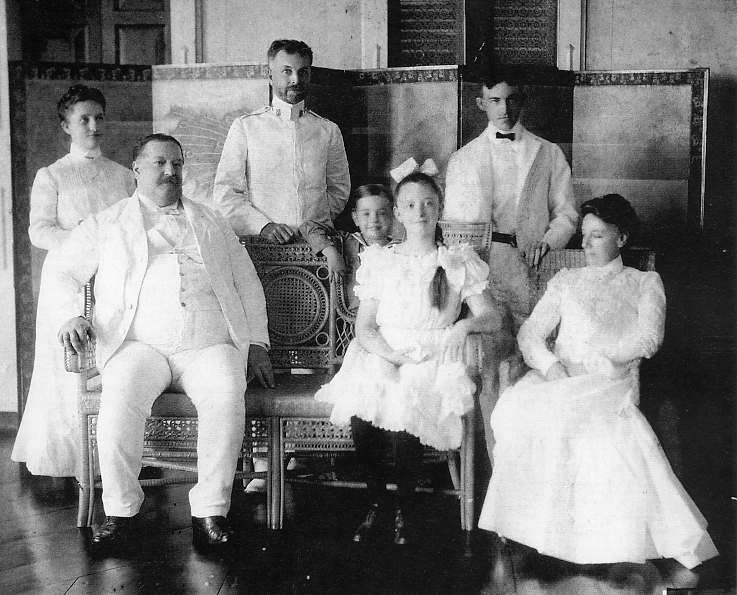
William Howard Taft and
family
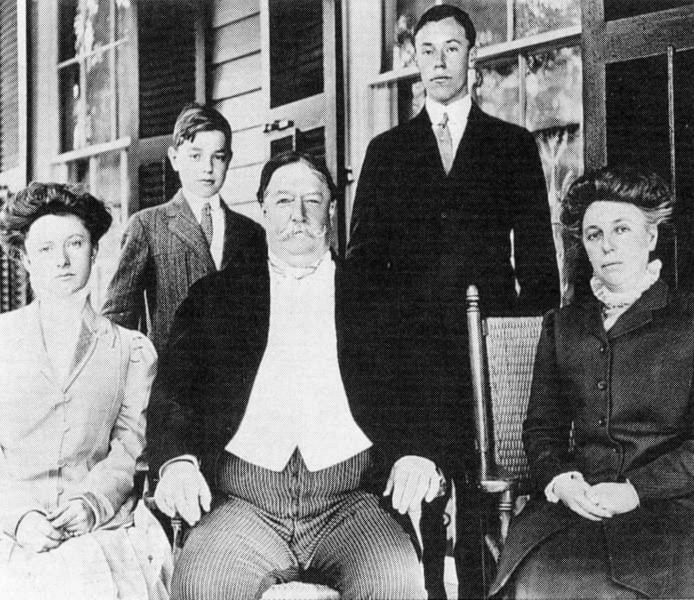
William Howard Taft and
family
William Howard Taft campaigning - 1908
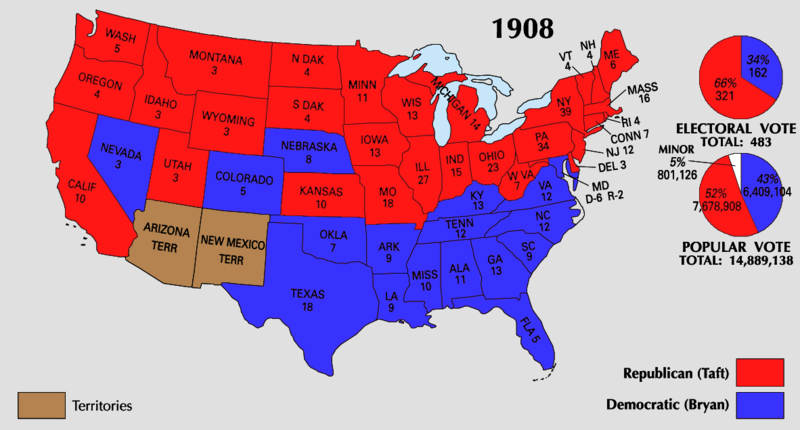
The Presidential Election of 1908
Theodore Roosevelt and William Howard Taft – Inauguration Day, 1909
Taft as U.S. President
Taft and his Cabinet
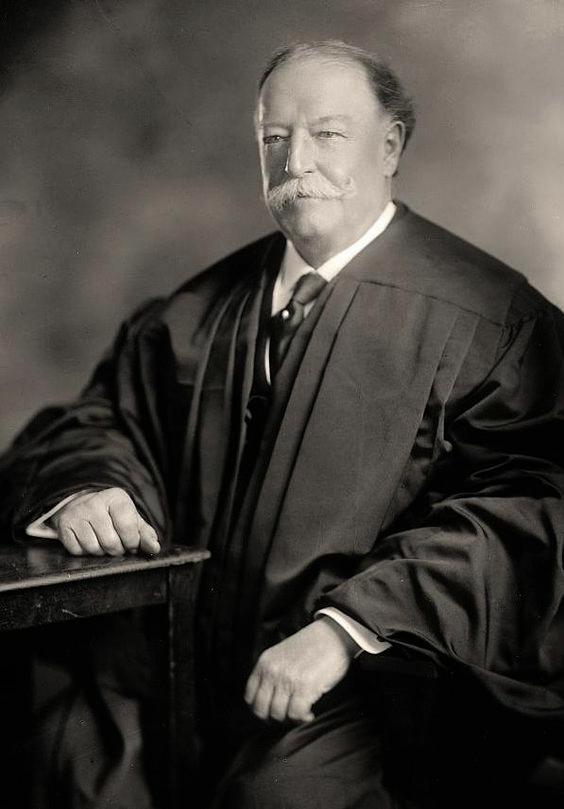

|
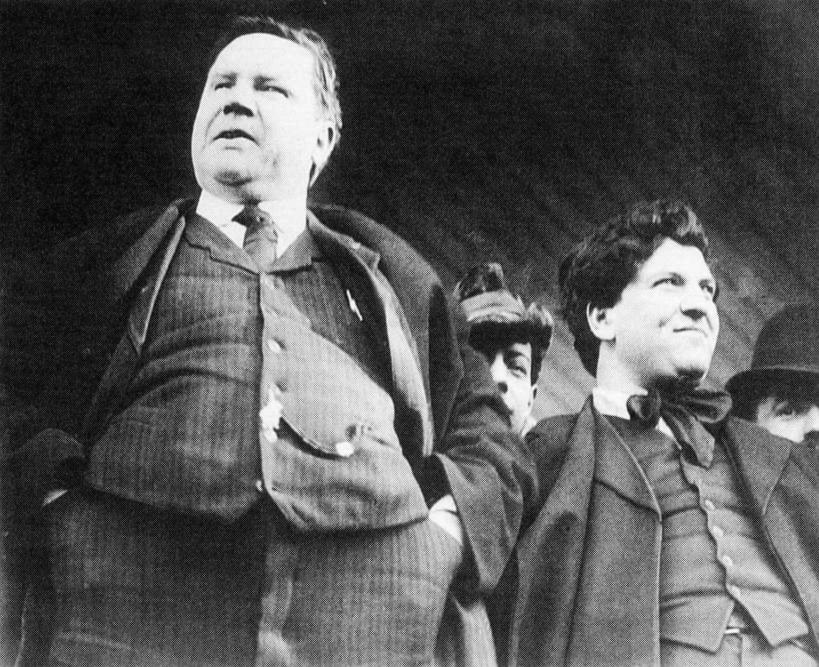
Big Bill Haywood (leader
of the Industrial Workers of the World – IWW – or "Wobblies")
and "Smiling Joe" Ettor
- 1910s
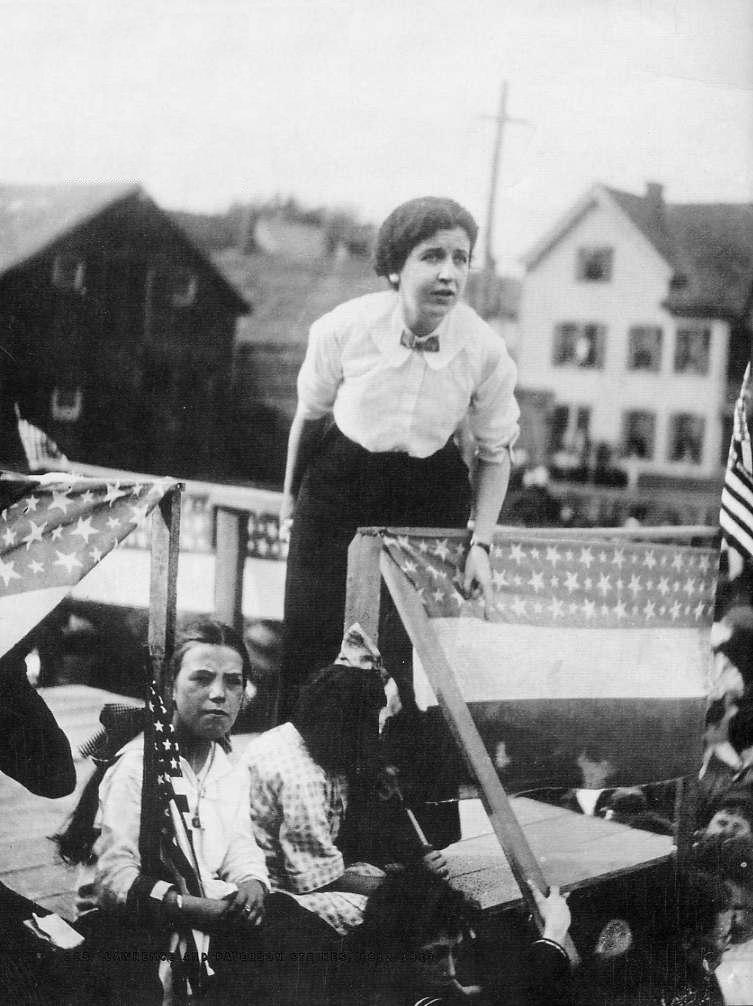
Elizabeth Gurley Flynn -
"Rebel Girl" IWW trade unionist
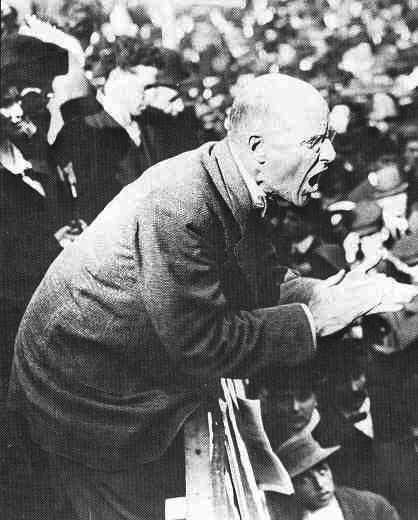
Socialist Eugene Debs stumping
for the Presidential election – 1912
Eugene Debs
Radical libertarian (even Anarchist)
"Red
Emma" Goldman (1869-1940)
| As a 16-year old
she
immigrated to America in
1885 with her Lithuanian
sister.
She failed in an
attempt in 1892 to assassinate capitalist Henry Clay Frick and was sentenced to 22
years in
prison. After her release
she was arrested several
times for
various actions – including opposing the wartime draft in 1917. She
was
deported to Russia in 1919 for her support of Lenin's revolution – but soon opposed it as
well. |


 Miles
H. Hodges
Miles
H. Hodges